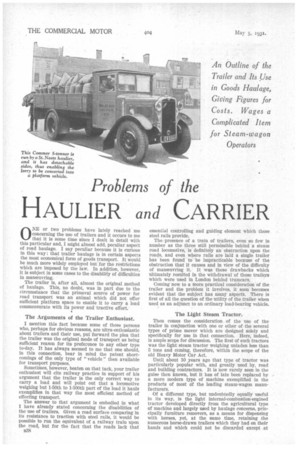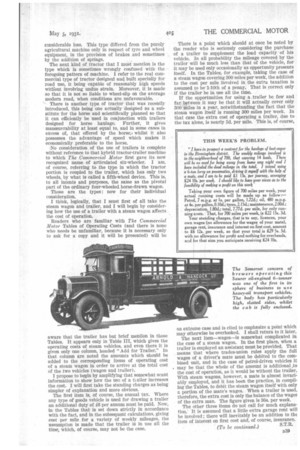Problems of the
Page 56

Page 57

If you've noticed an error in this article please click here to report it so we can fix it.
HAULIER and CARRIER
An Outline of the Trailer and Its Use in Goods Haulage, Giving Figures for Costs. Wages a Complicated Item for Steam-wagon Operators
ONE or two problems have lately reached me concerning the use of trailers and it occurs to me that it is some time since I dealt in detail with this particular and, I might almost add, peculiar aspect of road haulage. I say peculiar because it is curious in this way : that trailer haulage is in certain aspects the most economical form of goods transport. It would be much more widely employed but for the restrictions which are imposed by the law. In addition, however, it is subject in some cases to the disability of difficulties in manceuvring.
The trailer is, after all, almost the original method of haulage. This, no doubt, was in part due to the circumstance that the primeval source of power for road transport was an animal which did not offer sufficient platform space to enable it to carry a load commensurate with its power and tractive effort.
The Arguments of the Trailer Enthusiast.
I mention this fact because some of those persons who, perhaps for obvious reasons, are ultra-enthusiastic about trailers and their use, put forward the plea that the trailer was the original mode of transport as being sufficient reason for its preference to any other type to-day. It has always seemed to me that one should, in this connection, bear in mind the patent shortcomings of the only type of " vehicle " then available for transport purposes.
Sometimes, however, beaten on that tack, your trailer enthusiast will cite railway practice in support of his argument that the trailer is the only correct way to carry a load and will point out that a locomotive weighing but 1-50th to 1-100th part of the load it hauls exemplifies in that way the most efficient method of effecting transport.
The answer to that argument is embodied in what I have already stated concerning the disabilities of the use of trailers. Given a road surface comparing in its resistance to traction with steel rails, it would be possible to run the equivalent of a railway train upon, the road, but for the fact that the roads lack that B38 essential controlling and guiding element which those steel rails provide.
The presence of a train of trailers, even so few in number as the three still permissible behind a steam road locomotive, is definitely an obstruction upon the roads, and even where rails are laid a single trailer has been found to be impracticable because of the obstruction that it causes and in view of the difficulty of manceuvring it. It wa)s these drawbacks which ultimately resulted in the withdrawal of those trailers which were used in London behind tramcars.
Coming now to a more practical consideration of the trailer and the problem it involves, it soon becomes evident that the subject has many aspects. There is first of all the question of the utility of the trailer when used as an adjunct to an ordinary load-bearing vehicle.
The Light Steam Tractor.
Then comes the consideration of the use of the trailer in conjunction with one or other of the several types of prime mover which are designed solely and specifically for use in that connection. Here, indeed, is ample scope for discussion. The first of such tractors was the light steam tractor weighing unladen less than 5 tons and ccming, therefore, within the scope of the old Heavy Motor Car Act.
Until about 10 years ago that type of tractor was particularly popular with, and greatly used by, road and building contractors. It is now rarely seen in the guise then known, but it has of late been replaced by a more modern type of machine exemplified in the products of most of the leading steam-wagon manufa cturers.
Of a different type, but undoubtedly equally useful in its way, is the light internal-combustion-engined tractor developed directly from the agricultural type of machine and largely used by haulage concerns, principally furniture removers, as a means for dispensing with horses, yet, at the same time, retaining the numerous horse-drawn trailers which they had on their hands and which could not be discarded except at considerable loss. This type differed from the purely agricultural machine only in respect of tyre and wheel equipment, in the provision of brakes and sometimes by the addition of springs.
The next kind of tractor that I must mention is the type which is sometimes wrongly confused with the foregoing pattern of machine. I refer to the real commercial type of tractor designed and built specially for road use, it being capable of reasonably high speeds without involving undue strain. Moreover, it is made so that it is not so liable to wheel-slip on the average modern road, when conditions are unfavourable.
There is another type of tractor that was recently introduced, this being one actually designed as a substitute for the horse and scientifically planned so that it can efficiently be used in conjunction with trailers designed for horse haulage. Further, it gives manceuvrability at least equal to, and in some cases in excess of, that offered by the horse,' whilst it also possesses the advantage of speed which makes it economically preferable to the horse.
No consideration of the use of trailers is complete without reference to that hybrid tractor-trailer machine to which The Commercial Motor first gave its now recognized name of articulated six-wheeler. I am, of course, referring to the type in which the tractor Portion is coupled to the trailer, which has only two wheels, by what is called a fifth-wheel device. This is, to all intents and purposes, the same as the pivotal part of the ordinary four-wheeled, horse-drawn wagon.
Those are the types: now for their individual consideration.
I think, logically, that I must first of all take the steam wagon and trailer, and I will begin by considering how the use of a trailer with a steam wagon affects the cost of operation.
Readers who are familiar with The Commercial Motor Tables of Operating Costs (and there is none who needs be unfamiliar, because it is necessary only to ask for a copy and it will be presented) will be aware that the trailer has but brief mention in those Tables. It appears only in Table III, which gives the operating costs of steam vehicles, and even there it is given only one column, headed "Add for Trailer." In that column are noted the amounts which should be added to the corresponding items of operating cost of a steam wagon in order to arrive at the total cost of the two vehicles (wagon and trailer).
I propose to begin by amplifying that somewhat scant information to show how the use of a ti ailer increases the cost. I will first take the standing charges as being simpler of explanation and more obvious.
The first item is, of course, the annual tax. Where any type of goods vehicle is used for drawing a trailer an additional dnty of £6 per annum must be paid. Now, in the Tables that is set down strictly in accordance with the fact, and in the subsequent calculations, giving cost per mile for a variety of weekly mileages, the assumption is made that the trailer ist in use all the time, which, of course, may not be the case. There is a point which should at once be noted by the reader who is seriously considering the purchase of a trailer to supplement die load capacity of his vehicle. In all probability the mileage covered by the trailer will be much less than that of the vehicle, for it may be used only occasionally as opportunity presents itself. In the Tables, for example, taking the case of a steam wagon covering 300 miles per week, the addition to the cost per mile involved in the extra taxation is assumed to be 1-10th of a penny. That is correct only if the trailer be in use all the time.
If the opportunities for using a trailer be few and far between it may be that it will actually cover only 300 miles in a year, notwithstanding the fact that the steam wagon itself is running 300 miles per week. In that case the extra cost of operating a trailer, due to the tax alone, is nearly 5d. per mile. This is, of course, an extreme case and is cited to emphasize a point which may otherwise be overlooked. I shall return to it later. The next item—wages—is somewhat complicated in the case of a steam wagon. In the first place, when a trailer is employed an assistant must be provided. That means that where trades-union rules apply the full wages of a driver's mate must be debited to the combined unit, and in the case of petrol-driven vehicles it . may be that the whole of the amount is additionaljo the cost of operation, as it would be without the trailer. With steam wagons, however, a mate is almost invariably employed, and it has been the practice, in compiling the Tables, to debit the steam wagon itself with only a portion of the mate's wages. When a trailer is used, therefore, the extra cost is only the balance of the wages of the extra man. The figure given is 36s. per week.
The other three items do not call for much explanation: It is assumed that a little extra garage rent will be involved ; there will inevitably be an addition to the item of interest on first cost and, of course, insurance.




































































































